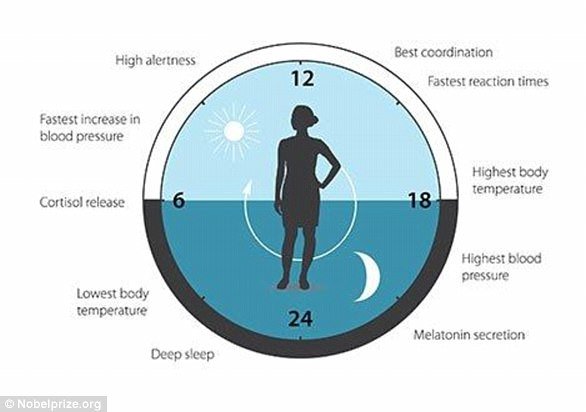Disruptions to the body’s internal clock — known as circadian rhythms — may significantly elevate the risk of premature death, according to a major new study published in Scientific Reports. Researchers analyzing data from large-scale U.S. and Chinese populations found that adults aged 40 and over with disrupted circadian rhythms faced heightened mortality from cardiovascular, metabolic, renal, and neurodegenerative diseases.
The study is the first of its kind to establish a comprehensive link between Circadian Syndrome (CircS) — a cluster of sleep, mood, and metabolic disruptions — and both all-cause and cause-specific mortality, providing compelling evidence that lifestyle interventions targeting circadian health could be life-saving.
What Is Circadian Syndrome?
Circadian rhythms are the natural, near-24-hour biological cycles that regulate sleep-wake patterns, hormone production, metabolism, and immune function. These rhythms are controlled by the suprachiasmatic nucleus in the brain’s hypothalamus. Disruptions to these rhythms — caused by shift work, poor sleep hygiene, or chronic stress — have been previously linked to a host of chronic illnesses, including Alzheimer’s disease, diabetes, and cardiovascular disorders.
READ MORE: New Biomarker Predicts Multiple Sclerosis Progression, Offering Hope for Better Treatment Strategies
CircS extends the traditional concept of Metabolic Syndrome by incorporating two additional components: sleep deprivation and depressive symptoms, alongside the usual markers such as central obesity, high blood pressure, elevated triglycerides, low HDL cholesterol, and hyperglycemia.
Participants were classified as having CircS if they presented four or more of these seven risk factors.
Study Overview
The researchers drew on two prominent datasets: the China Health and Retirement Longitudinal Study (CHARLS) and the U.S. National Health and Nutrition Examination Survey (NHANES). After filtering for complete and relevant data, the study included 7,637 participants from China and 9,320 from the United States, all aged 40 or older.
Key analytical methods included Cox proportional hazard models for assessing mortality risk and Bayesian generalized linear models for refined estimates. Mortality follow-up spanned 8.26 years in China and 7.4 years in the U.S., using death registry records and standardized interviews.
Key Findings
The study’s findings were both robust and alarming:
- CircS was strongly associated with increased all-cause mortality in both populations.
- Chinese cohort: Hazard Ratio (HR) 1.79
- U.S. cohort: HR 1.21, with even higher risk among adults aged 40–60.
- In the U.S., CircS significantly correlated with death from:
- Diabetes (HR 6.81)
- Kidney disease (HR 2.49)
- Cardiovascular disease
- Alzheimer’s disease
- Malignant cancers
- Infectious diseases such as pneumonia and influenza
- Component analysis revealed that depression, large waist circumference, hypertension, and hyperglycemia were the most predictive of early death.
- Mortality rates per 1,000 person-years:
- China: CircS group 2.9 vs. non-CircS group 2.0
- U.S.: CircS group 18.56 vs. non-CircS group 10.90
Notably, while the study confirmed a graded relationship between the number of CircS components and mortality, the trend’s linearity was only borderline significant (p = 0.06), suggesting more nuanced factors may influence risk accumulation.
Biological Mechanisms and Implications
The researchers theorize that CircS contributes to systemic biological disruption, affecting vascular, inflammatory, metabolic, and cognitive pathways. These mechanisms likely lead to increased vulnerability to chronic diseases and impair the body’s ability to repair and regulate itself — especially dangerous in middle-aged and older adults.
“The inclusion of depression and sleep deprivation in the CircS model reflects the expanding understanding of how lifestyle and behavioral health directly influence physical disease progression,” the authors noted.
Strengths and Limitations
Strengths:
- Large, multi-national cohorts with long follow-up durations
- Inclusion of Bayesian modeling for precise estimation
- Analysis of both all-cause and cause-specific mortality
Limitations:
- Self-reported data may be prone to recall bias
- Physical activity and dietary intake not accounted for
- Cause-specific mortality data not available for the Chinese cohort
- Findings may underestimate associations due to unmeasured confounders
A Call for Early Intervention
The results underscore the urgent need for early screening and preventive strategies targeting CircS components. Because many risk factors — like poor sleep habits, depressive symptoms, and metabolic imbalances — are modifiable, public health initiatives could substantially reduce morbidity and mortality by promoting circadian health.
Lifestyle recommendations include:
- Establishing consistent sleep routines
- Reducing excessive light exposure at night
- Encouraging healthy dietary and exercise habits
- Providing support for mental health and work-life balance, especially among shift workers
Conclusion
This study reinforces that circadian health is central to overall health — not merely a background process but a critical biological framework tied to longevity. Disrupted circadian rhythms are not only an inconvenience; they represent a significant, modifiable risk factor for early death.
As the modern world continues to challenge our biological clocks with technology, stress, and irregular schedules, the findings offer a timely reminder: restoring balance to the body’s rhythms may be one of the most powerful — and overlooked — paths to a longer life.
